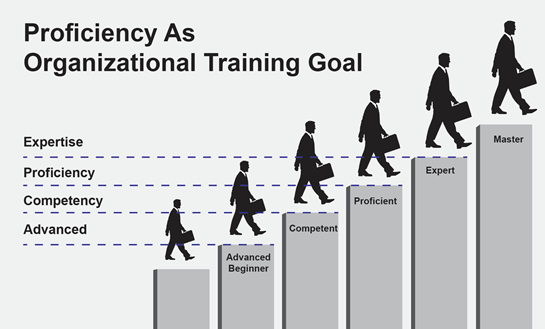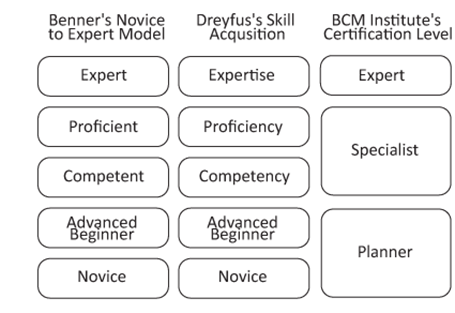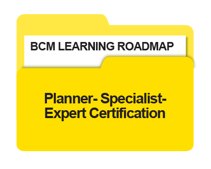“Novice to Expert” BCM Learning Roadmap
 This chapter describes the basics of how the competency level of BCM Institute’s training and learning program is designed.
This chapter describes the basics of how the competency level of BCM Institute’s training and learning program is designed.
It Is vital to note that the scope of BCM includes not only BC planning but also, crisis communication, crisis management, IT disaster recovery planning, and BCM auditing.
Training and Learning Roadmap
A Training and Learning Roadmap (referred to as “Learning Roadmap”) is a map to identify the order of learning, training, and experiences that can be developed to attain BCM competency.
A learning roadmap grooms employees specifically BCM practitioners for the next level of their careers and as a progression from a “novice” to an “expert” BCM professional. The roadmap arms the professionals with the appropriate BCM skills to allow them to make valuable contributions to the implementation and continual improvement of the organization’s BCM program.
A learning roadmap helps individuals grow personally and professionally, which in turn increases employee engagement, stems attrition, and curtails hiring costs.
Novice to Expert Model for BCM Professionals
The basis of the BCM learning roadmap is supported using the five-stage model of skill acquisition put forward by the Dreyfus and Dreyfus (1986) model. The Dreyfus and Dreyfus model of skill acquisition proposed that mastery in any field requires any practitioner to move through five distinct stages: novice; advanced beginner; competency; proficiency and expertise.
Benner (1982) applied the Dreyfus and Dreyfus model to her novice to expert five-stage model. This progression from novice to expert occurs over a continuum of time, and it also reflects three kinds of change to any BCM practitioner. This shift or progression involves the development of competence in knowledge and skills.

Referencing to the two established models from Dreyfuss and Benner, the five stages or levels were closely aligned with the characteristics of each BCM professional. Based on the depth of BCM knowledge and skill required at the “Planner-Specialist-Expert” certification level of BCM Institute’s certification programme (2016), Figure 2-1 was developed.

Figure 2-1: Alignment of Novice to Expert model to BCM Institute's Certification Programme (Benner, 1982; Dreyfus and Dreyfus, 1986; BCM Institute, 2015)
The five skill level from both Benner (1984) and Dreyfus (1986) was collapsed into BCM Institute’s three certification levels, “Planner-Specialist-Expert” levels. Figure 2-1 is an example of a formal BCM learning model, and BCM Institute’s certification courses. These three models are synchronised to serve and support the development of the formal (learning) model of a BCM professional.
The current practice in BCM learning focuses primarily on formal learning. As the expert continues to develop his/her skills and knowledge, other interested BCM professionals should seek alternative methods of learning and progress through non-formal and informal forms of learning.
Difference Between a BCM Novice and Expert
Before embarking on developing the learning roadmap, it is reasoned that mastering of skill is not simply by the acquisition of more BCM knowledge. A perfect analogy would be that of children growing up to be adults; as adults (experts) are not simply bigger children (novices). Experts are not only more knowledgeable, smarter and faster than the novices; the main difference is how experts approach any problems and how they perceive the world. It is essential to understand the desired or future state for BCM learning.
This difference can be seen through how a novice or expert is attempting to implement or manage a BCM project or programme. While the novice BCM professional will need detailed planning steps and guidelines to prepare even the simplest of planning or managing steps, the expert BCM professional does not require the explicit memory of all the planning or managing steps.
In fact, if they are any unexpected change in the BCM project or programme, even if one that was never made before, the BCM expert can intuitively pull it off as this expert seems to ‘just know'.

Reference
Goh, M. H. (2021). A Manager's Guide to Implement Your BCM Training and Learning Roadmap. Business Continuity Management Manager's Guide Series (3rd ed.). Singapore: GMH Pte Ltd.
Extracted from "Chapter 2: Planner-Specialist-Expert Certification"
More Information About Blended Learning BCM-5000 [BL-B-5]
To know more about our blended learning program and when the next course is scheduled, feel free to contact our friendly course consultant colleagues via sales.ap@bcm-institute.org. They are the BL-B-3 Blended Learning BCM-300 ISO22301 BCMS Implementer and the BL-B-5 Blended Learning BCM-5000 ISO22301 BCMS Expert Implementer.
![FAQ [BL-B-3]](https://no-cache.hubspot.com/cta/default/3893111/b3824ba1-7aa1-4eb6-bef8-94f57121c5ae.png) |
Please feel free to send us a note if you have any of these questions to sales.ap@bcm-institute.org |
 |










